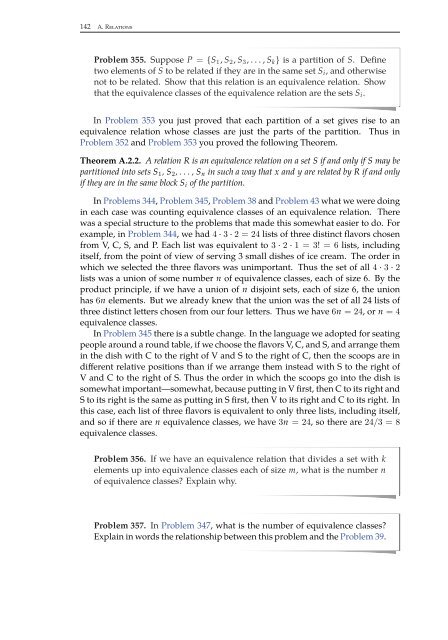Combinatorics Through Guided Discovery, 2004a
Combinatorics Through Guided Discovery, 2004a
Combinatorics Through Guided Discovery, 2004a
Create successful ePaper yourself
Turn your PDF publications into a flip-book with our unique Google optimized e-Paper software.
142 A. Relations<br />
Problem 355. Suppose P = {S 1 , S 2 , S 3 ,...,S k } is a partition of S. Define<br />
two elements of S to be related if they are in the same set S i , and otherwise<br />
not to be related. Show that this relation is an equivalence relation. Show<br />
that the equivalence classes of the equivalence relation are the sets S i .<br />
In Problem 353 you just proved that each partition of a set gives rise to an<br />
equivalence relation whose classes are just the parts of the partition. Thus in<br />
Problem 352 and Problem 353 you proved the following Theorem.<br />
Theorem A.2.2. A relation R is an equivalence relation on a set S if and only if S may be<br />
partitioned into sets S 1 , S 2 ,...,S n in such a way that x and y are related by R if and only<br />
if they are in the same block S i of the partition.<br />
In Problems 344, Problem 345, Problem 38 and Problem 43 what we were doing<br />
in each case was counting equivalence classes of an equivalence relation. There<br />
was a special structure to the problems that made this somewhat easier to do. For<br />
example, in Problem 344, we had 4 · 3 · 2=24lists of three distinct flavors chosen<br />
from V, C, S, and P. Each list was equivalent to 3 · 2 · 1=3!=6lists, including<br />
itself, from the point of view of serving 3 small dishes of ice cream. The order in<br />
which we selected the three flavors was unimportant. Thus the set of all 4 · 3 · 2<br />
lists was a union of some number n of equivalence classes, each of size 6. By the<br />
product principle, if we have a union of n disjoint sets, each of size 6, the union<br />
has 6n elements. But we already knew that the union was the set of all 24 lists of<br />
three distinct letters chosen from our four letters. Thus we have 6n =24,orn =4<br />
equivalence classes.<br />
In Problem 345 there is a subtle change. In the language we adopted for seating<br />
people around a round table, if we choose the flavors V, C, and S, and arrange them<br />
in the dish with C to the right of V and S to the right of C, then the scoops are in<br />
different relative positions than if we arrange them instead with S to the right of<br />
V and C to the right of S. Thus the order in which the scoops go into the dish is<br />
somewhat important—somewhat, because putting in V first, then C to its right and<br />
S to its right is the same as putting in S first, then V to its right and C to its right. In<br />
this case, each list of three flavors is equivalent to only three lists, including itself,<br />
and so if there are n equivalence classes, we have 3n =24, so there are 24/3 = 8<br />
equivalence classes.<br />
Problem 356. If we have an equivalence relation that divides a set with k<br />
elements up into equivalence classes each of size m, what is the number n<br />
of equivalence classes? Explain why.<br />
Problem 357. In Problem 347, what is the number of equivalence classes?<br />
Explain in words the relationship between this problem and the Problem 39.


















